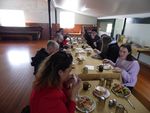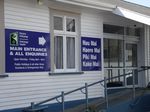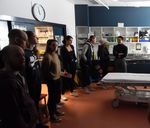Noho Marae ki Ngāwhā - Students of Rural Health Aotearoa
←
→
Page content transcription
If your browser does not render page correctly, please read the page content below
Noho Marae ki Ngāwhā
AIMS: To expose Auckland faculty of medicine and health sciences students to rural
communities of Northland, and to inspire them to pursue careers in rural health.
How did we fulfil these aims?
We took students to a marae noho at Ngāwhā marae just outside of Kaikohe. We were able to
expose students to locals from Kaikohe and surrounding areas, sharing their experiences of
day to day living and some experiences in the health system.
On arrival, we had a whakatau
ceremony to welcome the
students onto the marae. Soon
thereafter we had a hākari (feast)
to bring the haukāinga(hosts)
and the student group together.
Our first session was with the
amazing Heeni Hoterene
(pictured on left) who taught us
about the Maramataka Māori
(Māori lunar calendar). She
taught us about how our lives are
shaped by the physical
environment around us.She highlighted how we live in a
calendar that is still catered for
the northern hemisphere and
doesn’t follow the natural cycles
observed here in Aotearoa. Heeni
spoke to us about the different
energies of the days, the Māori
Atua (gods) who governed the
different days and environmental
aspects associated with them.
Heeni emphasised the importance of self-
awareness and the ability to reflect and
promote self-care during the winter months.
She pointed out our under-utilisation of the
summer months in stark contrast with the
behaviours of traditional Māori ways of life
where the summer months are the most
productive and energetic in preparation for
winter.
We then went to the healing Ngāwhā springs
that bubble up due to the geothermal activity
of the region. We are told that these springs
were where Hone Heke recovered during the
battle of Ōhaeawai Pā in 1845.The next day we drove out to
Rāwene hospital to see rural
health practitioners in action. We
were welcomed on with a pōwhiri
and encouraged to explore the
importance of rural healthcare and
Māori health, with a warm
welcome to return to Rāwene in
the future to gain experience and
assist the community. There we
learnt about how the hospital
caters for its rural community and
the new ways of practice they are
implementing - some such as
Rongoā Māori (traditional Māori
medicine)
The new Whānau room serves
multiple purposes of facilitating
whānau integration into patient
care plans, as well as a
community hub for outpatients in
the community during times of
flooding/ power outages.
(Rongoā Māori)Dr.Mark Lankshear, the medical director of the hospital, gave us a personal tour of the facilities. We saw the beautiful recent renovations, which involved a huge participation of the local community’s tradespeople. The hospital truly is designed by and for the people it serves. The hospital had new infectious disease control rooms fully updated with negative pressure capabilities to better contain outbreaks from the community. New maternity facilities updated to better support expectant mothers and their whānau surrounding the birth of their new child. Dr.Lankshear emphasised the importance of midwives in the community and their involvement with expectant mothers. Lastly, we gathered together with Hone Taimona (the head kaumātua advisor for the hospital) who spoke about how to develop our skills to better interact with Māori and rural communities. He gave us an extensive resource that helped us understand Te Ao Māori, along with some amazing sentences and vocabulary to use surrounding healthcare practice and hospital jargon. He emphasised that not all Māori people can speak Te Reo, but that integrating Te Reo into our practices would improve the rapport and satisfaction for our Māori patients in the future.
(A quick farewell photo before
we’re off to the next session!)
Our next session was with Atarangi Muru teaching us the traditional art of Romiromi (deep
tissue massage). She taught us about different pressure points and how they could improve
our sleep, thinking, posture and many other ailments we might have. Romiromi was
performed using rākau (sticks) to manipulate our feet and spine into better positions,
releasing tension to improve posture. Atarangi emphasised the importance of the ankles as the
foundation for the rest of the body, if the ankles are off centre or weak, then a ripple effect is
observed, with knee pain, weak hips, back pain and problems in the neck.
The final session of the day was a talk from Hemaima Reihana-Tait, who worked in Mahitahi
Hauora - Northland’s primary health entity. She shared inspirational kōrero explaining the
importance of acknowledging and understanding health inequities, rural and Māori culture,social determinants of health and how the health services of Northland work together to form
the Northland health system.
On our final day, we had a
poroporoaki (farewell) ceremony.
Kawhena Woodman and ‘uncle Bim’
spoke about the local area of Ngāwhā,
speaking about their experiences
growing up in and around the marae,
their schooling in rural communities
and the general culture of the greater
Northland region.
After leaving the marae, we went to
the urupā (cemetery) to visit the site of
the battle of Ōhaeawai Pā of July
1845. There Uncle Bim gave a
recounting of the Rangatira (chief)
Pene Taui and how he withstood the
British bombardment and the first
instance of the “Gunfighter Pā”. As
we visited Kawhena’s mother’s grave
and the Wā/Woodman plot, he pointed
out the differences in age between his
Pākehā father and Māori relatives, a
stark reminder of the health inequities
experienced in Aotearoa.
After entering the church which sat in the urupā we went to see the ancestral spring Ngā
Puna-wai of Ngāwhā, which was the traditional water source and a pātaka (pantry) for
watercress.
A big mihi must go out to Bailey’s whānau, who hosted us on this trip. They spoilt us with
amazing food and incredible hospitality, showing us exactly what we are missing out on,
further encouraging us to move into rural communities. Ka wani kē koutou! Arohanui ki a
koutou.This trip has inspired many of the students to not
only pursue rural health but to one day return to
Northland to dive deeper into the rich culture we
were exposed to. This trip wouldn’t have been
possible without the help of the New Zealand
Rural General Practice Network (NZRGPN)!
Also, an acknowledgement to Students of Rural
Health Aotearoa (SoRHA) for helping to build
networks and increased exposure between health
students and rural practices. No doubt this
opportunity to visit a rural community has lit a
flame within our students to go rural and support
the communities which
so badly need and
welcome us.
Ngā mihi maioha rawa
ake ki a koutou, mō tōu
awhiawhi i a mātou. Arā
ko te manu e kai ana te
Miro, nōna te ngāhere,
ko te manu e kai ana te
mātauranga nōna te Ao.
Greatest of
acknowledgements to
you for supporting our
journey. The bird who
eats the Miro berry,
theirs is the forest, but
the bird who seeks
knowledge, theirs is the
world.You can also read



























































